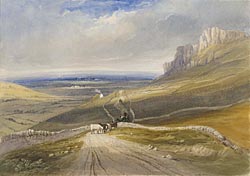| Landscape & Townscape |
For many years Staffordshire was thought of by those who knew little or nothing of it as a smoky county, consisting only of the Potteries and the Black Country. Its natural beauty from Kinver Edge in the far south west, through Cannock Chase and the Trent Valley to the dramatic Staffordshire Moorlands in the north, was overlooked, unappreciated or unknown. The contrast between Staffordshire’s natural landscape and its industrial face was aptly summed up by Arnold Bennett, the Potteries author, who wrote of his own county in 1908: “England can show nothing more beautiful and nothing uglier than the works of nature and the works of man to be seen within the limits of the county”.
However the activities of man have impacted upon the landscape of the county from the earliest times. From the establishment of the Roman road called Watling Street in AD 50, through the development of mediaeval settlements in clearings in Staffordshire’s many forest areas and the impact of centuries of farming practice to the county’s former industrial pre-eminence, all of these and more have shaped the county’s landscape.
The interaction of industry and agriculture had an important impact on Staffordshire’s landscape. Large landowning families such as the Dukes of Sutherland invested in the canals and railways. Men who made their money out of manufacturing bought large landed estates. The old money which came from land and the new money which came from industry was invested in improvements to the landscape and new building in both town and country, transforming the county’s landscape.
Today much of the impact of the county’s earlier industries on the landscape has been mitigated. As former industries have ceased production, so the evidence of their activity has either been converted, landscaped or re-developed. Urban renewal continues apace. Industrial sites have taken on new roles. Some industrial buildings, such as the former mills and factories in towns such as Leek and Stafford, have been converted into homes or offices, so preserving some character of the working past.
The diversity of Staffordshire’s landscape reflects a varied history and past. |
|

Archive Sources
The Leek Rocks on the Road to Flash.
Watercolour drawing by LJ Wood, c 1835-1840
Rock houses at Kinver Edge.
Sepia drawing by Thomas Peploe Wood, 1837
Plan of the town of Tamworth, 1741, surveyed by
William Wyatt
Plan of proposed alterations to the landscaping at Trentham by Lancelot Brown, 1759.
Enclosure map for the parish of Yoxall, 1815
Photograph of Cannock Chase, 1892
Design for Moreton Church and Parsonage, 1842, by Thomas Trubshawe, FSA
Photograph of Wardle and Davenports’ Big Mill in Mill Street Leek, 1966
Plan of Hanley Park by T H Mawson, 1895
Elevation of Burton-upon-Trent Magistrates Court, designed by Henry Beck, architect of Burton-upon-Trent, 1908
|

